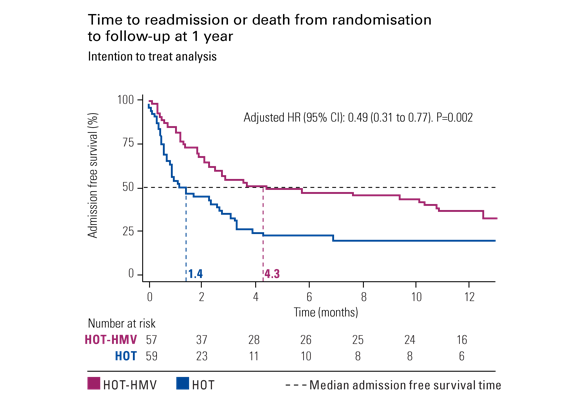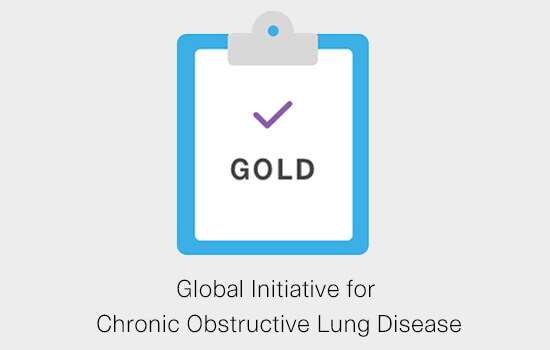Discover key findings from recent clinical research and their implications for treatment decision-making and patient selection.
The HOT-HMV study 1 has shown a 51% reduction in risk of hospital readmission or death in hypercapnic COPD patients treated with home non-invasive ventilation and oxygen therapy.


Following the outcome of the HOT-HMV study1, a health economics analysis was performed to assess the cost effectiveness of HOT-HMV when compared to HOT alone among COPD patients in the UK with persistent hypercapnia after a life-threatening exacerbation.2
The analysis indicates that the probability of HOT-HMV being cost effective is 62%, based on willingness to pay
Patients recovering from acute respiratory failure associated with an exacerbation of COPD should be evaluated at 2–4 weeks after resolution of respiratory acidosis, and those with persistent hypercapnia should be given home NIV.1
Stable COPD patients with chronic hypercapnic respiratory failure also benefit from home NIV.3
Differences in the timing of home NIV initiation might explain different outcomes between studies.1,4
.png)

Global Initiative for Chronic Obstructive Lung Disease (GOLD) guidelines state that home NIV may improve hospitalisation-free survival in selected patients after recent hospitalisation, particularly those with pronounced daytime persistent hypercapnia (PaCO2 ≥52 mmHg’, Level of Evidence = B).5

A multidisciplinary ERS Task Force committee has published evidence-based recommendations that conditionally support the application of LTH-NIV to improve health outcomes by using fixed pressure settings and targeting a reduction in carbon dioxide in COPD patients with persistent hypercapnic respiratory failure.6
Improving elevated arterial carbon dioxide levels should be one of the main goals of home NIV.7
Clinical trial data show that higher inspiratory pressures targeted at reducing elevated carbon dioxide levels contribute to the success of home NIV therapy.1,3
High-intensity NIV does not appear to have a negative impact on adherence, sleep quality, or quality of life.1,8,9
Sign up to receive home NIV clinical reviews and COPD patient tools. Tick the box if you’d like to register for our clinical newsletters!

Careful monitoring is essential for patients initiated on high-intensity NIV. This could be facilitated by telemedicine technology providing ventilatory data, patient-ventilator asynchrony, transcutaneous gas measures and other relevant parameters.
ResMed believes in the need to support ethical, independent clinical research, conducted by qualified third-party investigators.
Murphy P et al. Effect of Home Noninvasive Ventilation With Oxygen Therapy vs Oxygen Therapy Alone on Hospital Readmission or Death After an Acute COPD Exacerbation. A Randomized Clinical Trial, JAMA. Published online 21 May 2017. doi:10.1001/jama.2017.4451.
Murphy P et al. Effect of Home Noninvasive Ventilation With Oxygen Therapy vs Oxygen Therapy Alone on Hospital Readmission or Death After an Acute COPD Exacerbation. A Randomized Clinical Trial, JAMA. Published online 21 May 2017. doi:10.1001/jama.2017.4451.
Murphy PB et al. Cost-Effectiveness of Home Oxygen Therapy-Home Mechanical Ventilation (HOT-HMV) for the Treatment of Chronic Obstructive Pulmonary Disease (COPD) with Chronic Hypercapnic Respiratory Failure Following an Acute Exacerbation of COPD in the United Kingdom (UK). American Journal of Respiratory and Critical Care Medicine 2018;197:A2517.
Köhnlein T, et al., Non-invasive positive pressure ventilation for the treatment of severe stable chronic obstructive pulmonary disease: a prospective, multicentre, randomised, controlled clinical trial. Lancet Respir Med 2014;2:698-705.
Struik FM, et al. Nocturnal non-invasive ventilation in COPD patients with prolonged hypercapnia after ventilatory support for acute respiratory failure: a randomised, controlled, parallel-group study. Thorax 2014;69:826-34.
Vogelmeier DF, et al. Global strategy for diagnosis, management, and prevention of COPD. Am J Respir Crit Care Med 2017;195:557-82.
Ergan B, Oczkowski S, Rochwerg B, et al. European Respiratory Society Guideline on Long-term Home Non-Invasive Ventilation for Management of Chronic Obstructive Pulmonary Disease. Eur Respir J 2019; in press (https://doi.org/10.1183/13993003.01003-2019).
Nocturnal non-invasive positive pressure ventilation for COPD. Windisch W et al. Expert Rev Respir Med. 2015 Jun; 9(3):295-308.
Dreher M, et al. Noninvasive ventilation in COPD: impact of inspiratory pressure levels on sleep quality. Chest 2011;140:939-45.
Dreher M, et al. High-intensity versus low-intensity non-invasive ventilation in patients with stable hypercapnic COPD: a randomised crossover trial. Thorax 2010;65:303-8.